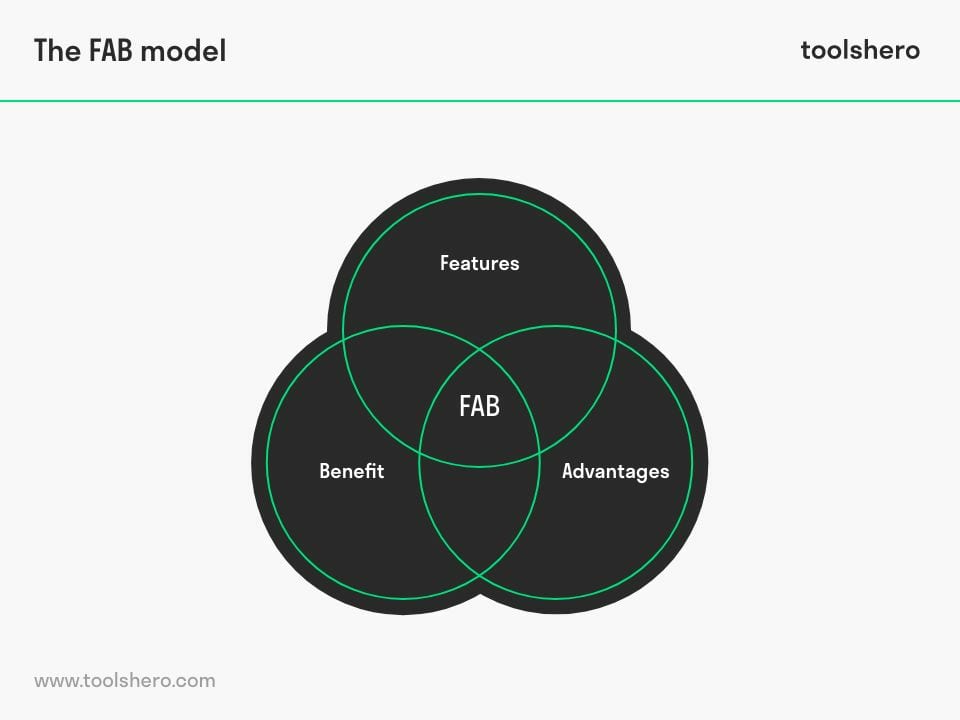FAB Analysis explained including examples

FAB analysis: this article explains the FAB analysis in a practical way. The article begins with the definition of the acronym FAB, followed by the difference between advantages and benefits, an overview of the analysis and some FAB Analysis product examples to make the theory concrete, and tips for when you want to use this marketing technique. Enjoy reading!
What is a FAB analysis?
Definition and acronym
A FAB analysis is a model that is used to define and develop a product, service or design. The name FAB is an acronym of the following elements:
- Features
- Advantages
- Benefits
Difference between advantages and benefits
Advantages and benefits seem to have the same meaning. Yet there is a small difference. Advantages explain the importance of a feature of a product and how it removes a particular problem from the user. This can be explained in a concrete and measurable way. Benefits are more subjective and appeal to the user’s emotions or pains.
The FAB model makes marketing teams think about the features and benefits of a product or service, mainly to understand the difference with the competitor’s products. Using this method ensures that the essence of a product is clearly understood. This helps the organization to position the product well in the market. The result of a FAB analysis is a so-called FAB statement.
FAB analysis, an overview
The FAB analysis serves as a tool for market research. It ensures that companies find out which product aspects need to be emphasized for good positioning. This means that the customer’s attention is effectively captured in a fiercely competitive environment.
1. Features
The functions and features of a product are essential in a customer’s decision whether or not to buy the product. The characteristics of a product are easily discernible. For example, they are physical characteristics such as the size and the color.
Features are important to the impact the product has in the customer’s daily life. Features distinguish one product from another. Advantages and features are sometimes closely related. The fact that a product has certain feature benefits can be an advantage over another product.
2. Advantages
Advantages are factors that make a product better than competitors’ products. These advantages are descriptive and not concrete. That means they don’t tell you exactly how the product will affect the customer’s life. For example, a large sofa is advantageous for a customer who is looking for a large piece of furniture for a large living room. Where it is an advantage for the customer with a large living room, it is a disadvantage for the customer who is looking for a smaller sofa for a smaller room.
This type of advantage provides a detailed description of a product’s features. It gives the customer a better understanding of the product’s features. These advantages depend on the circumstances.
3. Benefits
Benefits represent the value of a product to the customer, such as the use of high-quality materials that last. It is the main reason why a customer chooses the product over the competitor’s product. As the company develops and grows, the company must continue to monitor customers and their motivations.
Some customers buy a product purely on its features and advantages. If the product offers more extra benefits, they will be inclined to come back and buy the same product again.
FAB Analysis product examples
FAB Analysis of a product example for children’s clothing
Consider the example below of a short FAB analysis for a new children’s clothing brand.
For example, a FAB statement might look like this:
- Features: organically grown cotton, without bleach and non-toxic printing
- Advantages: good fit, seamless, hypoallergenic and suitable for repeated washing
- Benefits: durable, high-quality and wear-resistant
Another example: software application
A FAB statement for newly developed software:
- Features: application allows team members to communicate via text messages, video calling or voice recordings, and integration with other applications is possible
- Advantages: safe to use, accessible and easy to update
- Benefits: streamlines communication and error-proof
Tips
Writing a FAB statement is difficult for many marketers. Complexity can be partly removed if accurate data is available on which to base the statement. The key to writing a good statement is therefore gaining customer insights through questionnaires, interviews and other data collection methods. This makes it possible to precisely map out the needs and motives of the customers.
Once this data is obtained, an advantages and benefits analysis can follow and the marketer can focus on writing the FAB statement.
Now it’s your turn
What do you think? Do you recognize the explanation about the FAB analysis? Do you use this or a similar tool to position a brand you are working on? Are you aware of the features, advantages and benefits of your brand? What other branding and positioning tools are you familiar with? Do you have tips or comments?
Share your experience and knowledge in the comments box below.
More information
- De Ruyter, K., & Scholl, N. (1998). Positioning qualitative market research: reflections from theory and practice. Qualitative market research: An international journal, 1(1), 7-14.
- Kostelijk, E., & Alsem, K. J. (2020). Brand positioning: Connecting marketing strategy and communications. Routledge.
- Rodgers, P., & Milton, A. (2011). Product design. Laurence King.
- Yu Xie, H., & Boggs, D. J. (2006). Corporate branding versus product branding in emerging markets: A conceptual framework. Marketing intelligence & planning, 24(4), 347-364.
How to cite this article:
Janse, B. (2023). FAB Analysis. Retrieved [insert date] from Toolshero: https://www.toolshero.com/marketing/fab-analysis/
Original publication date: 02/24/2023 | Last update: 04/18/2023
Add a link to this page on your website:
<a href=”https://www.toolshero.com/marketing/fab-analysis/”>Toolshero: FAB Analysis</a>













